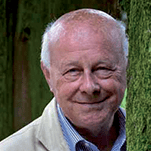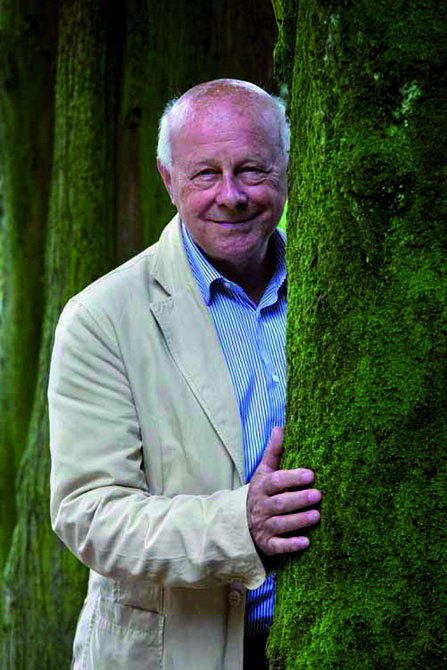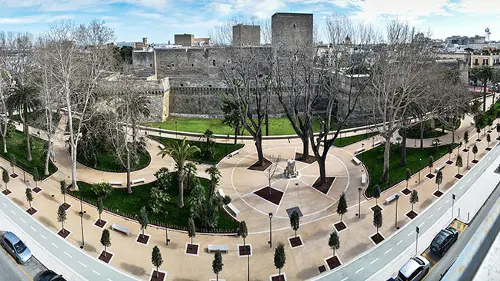
Natural, artificial, vegetable materials: the real challenge
We spoke with the landscape architect, Franco Giorgetta.
We spoke with the landscape architect, Franco Giorgetta.
Street furniture and urban décor are becoming increasingly important calling cards for cities: what is your opinion?
I’d like to start by making a slight distinction. All too often, when we talk about form and architecture with reference to open spaces, it is often called or confused with “street furniture”, which is something different. In fact, this is rather a collection or catalogue of individual objects, that are used as accessories to decorate open spaces. Their significance can vary, as can the way they coordinate with an open space, and one of the most striking examples of this is the catalogue of objects designed under the guidance of Adolphe Alphand for the transformation of Paris in the mid-19th century, which included every element and feature imaginable, from benches to monumental gates, from street lights to newsstands and billboards, from rubbish bins to kiosks.
Compared with these elements, which are decorative features in the true sense of the word, a more important role in the design, or style, of open spaces is played by the materials used; natural, artificial, vegetable, and particularly paving which, because it normally extends over such a large area, it tends to characterise the quality, including the expressive quality, and functionality of the space.
As for the importance of the quality of spaces to help appreciate a city or neighbourhood, I need to stress how open spaces play a vital role, and I would say it has always been that way: there’s no need to even mention places such as Piazza Navona or Piazza di Spagna in Rome, Piazza del Campo in Siena, and Times Square in New York. Maybe in more modern times, when industrial cities were growing in the period following the Second World War, urban planners had all but forgotten their role but, in more recent times, more and more focus has been put on them again.
Which are the most virtuous examples in Europe and around the world? And in Italy?
There are certain cornerstones of contemporary architecture’s approach to open spaces and the landscape, such as the work done along the banks of the river running through Bordeaux, where the Garonne estuary used to be an industrial area of the port, whereas today it has become the fulcrum of city life, with the creation of the extraordinary Miroir d’Eau, the central piazza, designed by Michel Corajoud, and then kilometres of parkland, gardens, equipment and warehouses converted into spaces open to the public with restaurants, cultural activities and sports facilities.
Other projects just as significant, but dating back a little further, was the transformation of the London Docklands area and the old port in Genoa, which was transformed by Renzo Piano from being a run-down, decommissioned industrial area into the heart of the city, a space that never closes, which every day becomes a hub for tourists, cultural events, congresses, exhibitions, shows, sports events, sailing, dining and shopping, from the Aquarium to the old Cotton Warehouses, from Piazza delle Feste to the Porta Siberia fortress, right down to the Trade Fair area.
In the centre of Milan, meanwhile, the most significant project is the transformation of the former Varesine railway works at Porta Nuova, with a system at the heart of it all formed by the lively Piazza Gae Aulenti, the “Trees Library” park and Piazza Lombardia, home of the local government offices. We can see around us other examples of rundown and decommissioned or abandoned areas that have been transformed.
Amongst these examples there are cornerstones and important reference projects, such as the transformation of the Millennium Park in Chicago, which was originally a station and railway hub and is now a magnificent public park in the heart of downtown Chicago with really high quality, stunning architecture. But what has met with even more public approval is the transformation in New York of the West Side Line, a stretch of elevated railway in the western part of Manhattan, into a garden and city park, now known as the High Line.
Over the last few years there has been a new awareness of the importance of communal spaces in cities: what stage are we at in this process of cultural change and in the implementation and execution of projects?
If we put to one side the desire to amaze at all costs, with all kinds of extravagant proposals, we are noticing the development of projects that are constantly improving, they are becoming more and more selective and more technically valid.
Style, form, design, but also a search for new materials. How important are these choices in making cities more welcoming and liveable?
Choosing which materials and technical solutions to use is very important.
Open spaces are almost always public spaces, or become so by means of a deed of transfer or easement once construction work has been completed by private developers.
However, because of the high cost of maintaining these spaces, and local authorities not having resources to carry out adequate maintenance, projects need to use durable, resistant materials that are able to provide and maintain proper performance properties over time, without losing their characteristics and technical or aesthetic qualities.
Sustainability and urban spaces are becoming more and more closely associated. In your opinion, what interventions should be prioritised in cities to take us in the right direction?
Sustainability: ecological, social and economic sustainability. Ecological and social basically means reducing our carbon footprint, that is, making the widest use possible of materials with raw materials and production processes, as well as transport options and application methods, with “low environmental impact”, paying careful attention to the hidden aspects of the impact they have, and on the use of materials and equipment which, if manufactured abroad, may conceal the fact that they severely damage the ecosystem and employ low-wage labour.
As far as economic issues are concerned, we need to be forward-thinking and careful about putting too much emphasis on the initial benefits of sustainability, while economic benefits must be calculated across the entire life cycle of a building or structure, including the final disposal of materials. Spend wisely at the outset to guarantee a long service life with low maintenance costs; this should be the golden rule. Which interventions should be prioritised? Parks and gardens! Plenty of parks and gardens in cities, and soft mobility. More pedestrian zones and cycle lanes, backed up by an extensive network of underground or elevated rail transport, without falling into the easy trap, and enticing promises, of apparently harmless electric vehicles, which are proclaimed as being emission-free, while disguising the fact that emissions are generated elsewhere (such as in fossil-fuel driven power stations that pollute other areas) to produce the energy required to manufacture, move and dispose of them.
On the subject of cities of the future, we shouldn’t overlook the issue of redeveloping outlying neighbourhoods and suburbs. How can landscape architecture contribute to the regeneration of such areas?
Redeveloping external spaces can make a significant contribution to redeveloping rundown areas in the poorer parts of cities. It provides the opportunity for redevelopment work in places with areas that need to be reclaimed, but this can only happen by means of a series of other kinds and types of concerted action. To put it more simply, a nice piazza may help a little, but it certainly doesn’t get rid of poverty.
Redevelopment projects on street furniture and décor are usually entrusted to local councils, but the private sector can also make a significant contribution. What is your opinion?
In Italy, most of the projects and plans for public open spaces rely on the initiative of private developers of urban regeneration programmes, normally under the control and in cooperation with local authorities. But the private sector does play a significant role in development plans, or redevelopment plans, for public open spaces.
Then there are areas in which residents can play a direct role, as individuals or in the form of groups and organisations, to stimulate or by taking direct action, like what happened in New York with the Guerrilla Gardening groups, which has also been replicated in Milan, or through a more peaceful approach such as the community gardens initiative on the Lower East Side in New York.












